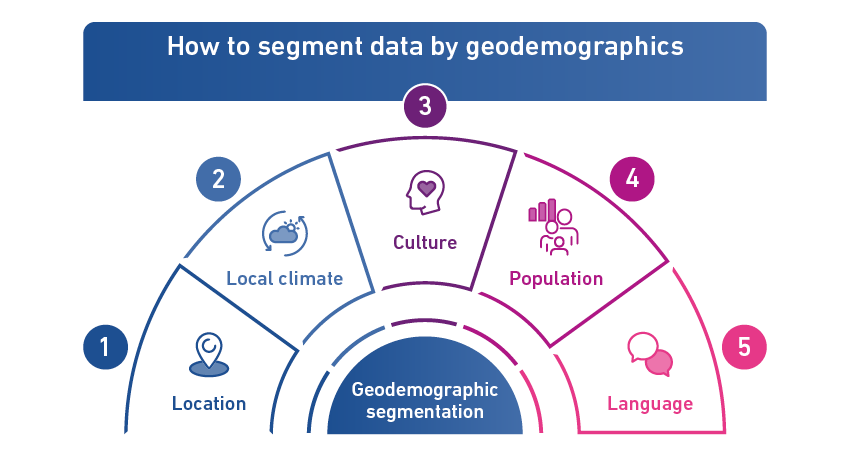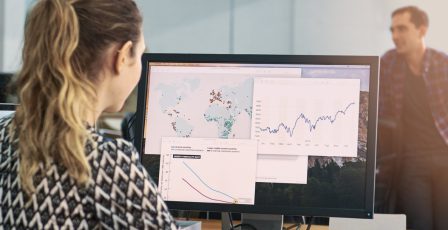What are geodemographics?
Geodemographics divides your target audience into groups based on their geographic and demographic characteristics. By analysing data collected regarding location, population density, climate, etc., businesses can craft precise consumer profiles.
Understanding your consumers is essential for success. The more you know about them, the better you can meet their needs. In this era of e-commerce and digital marketing, your target market is likely spread across regions and countries – perhaps all over the world. Geographic segmentation can help you create targeted marketing strategies and communicate effectively with your entire audience, so it’s important to understand geodemographics, how to use them, and what they can do for your business.
What are geodemographics?
First of all, it’s important to understand the difference between geographic and geodemographic. Geographic simply refers to a location, whereas geodemographics combines that information with demographic data to gain a better understanding of the people in a specific location.
Geodemographics divides your target audience into groups based on their geographic and demographic characteristics. By analysing data collected regarding location, population density, climate, etc., businesses can craft precise consumer profiles.
By understanding what your target market wants and needs in the various places that they’re from and tailoring your message accordingly, you’re able to form a more meaningful relationship with them.
Why is geodemographic segmentation important?
Geodemographic segmentation is a type of market segmentation that can transform a business’s marketing efforts. By understanding the lifestyle and demographic characteristics of people in specific areas, you’re able to understand and fulfil their wants and needs better. This can lead to better engagement, conversion rates and, ultimately, profits.
How to segment data by geodemographics
There are many ways you can segment your data by geodemographics. Often, the best method is to fuse them to provide a holistic understanding of your target audience by geography. Some of the ways you can segment your geographic data include:
Location
Segmenting data by location is about finding out how your customer’s country, city, and even postcode is influencing their wants, needs, and buying behaviours.
A business needs to consider where it serves. If it’s only a small geographical area, their entire advertising budget can be spent targeting that area. However, if your product or service serves a larger area, you must pay attention to the shift in what your audience might prefer or need throughout the different locations. For example, is there more or less availability for what you offer in certain places due to differing internet or shipping options? Are customers spending more in particular areas? These are the kinds of things which will inform a change in messaging in certain geographic segments.
Local Climate
Analysing and utilising climate data can help you create tailored campaigns for specific places and populations with far greater success. Weather and seasonal change are popular topics of conversation for a reason – they have a big effect on people’s day-to-day lives, and therefore, consumer behaviour.
An obvious market affected by climate is clothing. The messaging and products offered by clothing brands in the UK will change drastically from summer to winter, and even, though more subtly, from the North to the South.
It’s also important to consider that seasonal events, holidays, and especially local annual events differ depending on region. By taking this on board and incorporating it into your marketing message, your audience will feel seen and heard on a genuinely meaningful level.
Culture
Cultures and customs play a huge role in shaping consumer preferences. Considering the local culture of wherever you offer your products or services can level up marketing success.
Marketing in the UK can differ massively based on location. When selling a car, for example, it’s likely you’d put out a different message to your target audience in London to those in the countryside. For city dwellers who don’t need a vehicle as much, the marketing could lean more towards the luxury aspects of having a car; for the more rural owners who perhaps drive more than they would like out of necessity, the messaging might err on the side of eco-friendliness and fuel economy.
The examples above could all be about the same vehicle. Simply adjusting the messaging to appeal to different geographic cultures makes all the difference in how it’s received.
Population
Knowing the type of population in a geographic location can be extremely useful. By thinking about population in terms of urban, suburban, and rural, for example, we get an idea of the differing needs the population may have.
These three population types have distinct differences in their buying behaviours due to their varying lifestyles. Rural populations tend to be more sparsely populated and often, on average, have less disposable income. Both suburban and urban consumers, on the other hand, typically have more disposable income due to living in areas with more job opportunities. And high-density urban populations are often the most diverse, so speciality shops and other cultural businesses are more likely to thrive here.
Imagine a coffee franchise looking to market across the UK. A campaign focused on customers picking up a coffee on foot while on their way to the office would resonate a lot more with an urban audience than a rural one. By using geodemographics, the franchise would only push this campaign in cities, while tailoring a different message to push in rural areas. This also protects their brand identity from coming across as “out of touch” to non-urban audiences.
Language
Language is another key player in geodemographic segmentation, especially in multilingual areas.
This isn’t just about translation; it’s about appreciating the cultural and behavioural intricacies tied to language. For businesses, this means crafting advertisements that don’t just speak the language but resonate with the local sentiment.
And when marketing across countries, businesses can’t merely adopt a one-size-fits-all approach. The nuances between American and British English, or the different dialects across Spanish-speaking nations, require a keen understanding. This can be the difference between success and miscommunication.

Some examples of geodemographics
A simple example of geodemographics in play could be a coffee business that wants to expand. By analysing geographical and demographic data, it finds that specific neighbourhoods have a high population of professionals who consistently go out to buy coffee. With this knowledge, they can open a new shop in one of these areas, increasing their revenue.
Nestlé’s Kit Kat campaign in Japan is one of the best demonstrations of geodemographic segmentation at play. They understood their audience’s language to tailor their marketing campaign incredibly. Now, Kit Kats are one of the most popular chocolate bars in Japan, simply due to a quirk of their language.
In Japanese, you need to follow most consonant sounds with a vowel sound, making Kit Kat, ‘Kitto Katto’. The Nestlé team understood that that sounds a lot like the Japanese phrase: ‘kitto katsu’, meaning, ‘you will surely win’. Through thoroughly understanding the language, and leaning into Japan’s gift-giving culture, Nestlé Japan marketed the chocolate bar as a good luck present for university students, absolutely skyrocketing its popularity there.
How geodemographics can help your business
So it’s clear that, when done right, geodemographics can support winning marketing campaigns. But let’s break it down a little further with some of the specific benefits that segmenting via geographics and demographics can bring your business:
Develop accurate customer profiles for better targeting
The deeper the understanding of your consumers, the more precise the targeting in your campaigns. Instead of using a generic approach, you tailor your goods, services, and messaging to meet the specific wants and needs of each customer group. As well as increasing the effectiveness of your marketing, this will also lead to better customer satisfaction.
Expand your physical locations
Geographical demographics can guide expansion efforts for businesses with a physical presence. By analysing data to identify areas with a lot of potential customers, you can make informed decisions about where would be best to open new shops or outlets.
Create seasonal campaigns that speak to your audience
As we know, seasonality varies depending on the region – they’re not one-size-fits-all. Not taking the area’s local events, cultural climate and weather into account can cost your business. However, if you’re mindful of all of these, you can create campaigns that connect meaningfully to your target audience and get better results for your brand throughout the seasons.
Getting geodemographic data
So how do you go about accessing this valuable geodemographic data? Here are some potential methods:
- Market research
Use surveys, interviews, and questionnaires to help gather information about consumers in different areas. They can include questions about preferences, location, and cultural background.
- Third-party data providers
There are companies, like ours, that specialise in collecting geodemographic data. You can purchase this data for insight into the geographic and demographic traits of your target market.
Our geographic segmentations can be linked to every household in the UK (and many international regions) helping you to reach the right customers, in the right places, with the right message.
- Online analytics tools
Analytics platforms like Google Analytics, Adobe Analytics or social media analytics can provide geodemographic data about your website and social media visitors to your website and social media pages, like where most of your site traffic is coming from and, if you’re running ads, which locations have the highest conversion rate. This can help inform your customer profiles and marketing campaigns.
How can we help?
Geodemographic segmentation in marketing is a powerful tool for modern businesses. By analysing demographic and geographic factors such as location, climate, culture, population density, and languages spoken, you can better understand your target market. This way, you can target consumers geographically with campaigns and content you’re confident will land.
We have a proven approach to segmentation development, combining our breadth of market leading demographic and classification data with geographical insights and our customer’s own first party data, enabling you to:
 | Tailor marketing to specific regions to increase effectiveness and drive higher engagement and conversion rates |
|---|---|
 | Identify profitable areas to locate a business by analysing population density, income levels, and local competition |
 | Adapt products and services to meet customer needs in different regions |
 | Incorporate insights across demographic, geographic and transactional data |
 | Apply in real-time via API for enhanced insights |
Our geographic segmentation solution is a very cost-effective way to segment populations geographically allowing marketers to tailor their products, communication, and distribution strategies to the specific needs and preferences of customers in different geographic locations.
Find out more
We have the skills, experience and data resources to help you plan and execute your segmentation project – whether you want to understand your existing customers better, or you wish to size the market for your products and services.
Discover more about our advanced audience segmentation solutions to discover how you can weave all your market data, from geographic to attitudinal to behavioural, together for a rich understanding of your consumer base.











